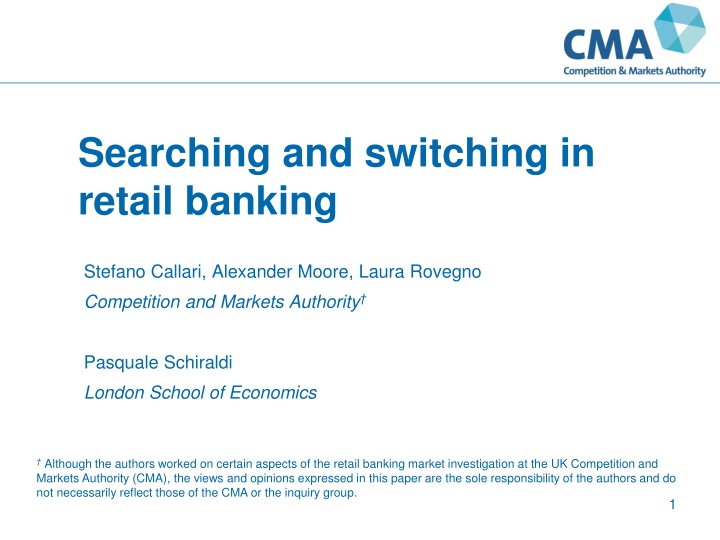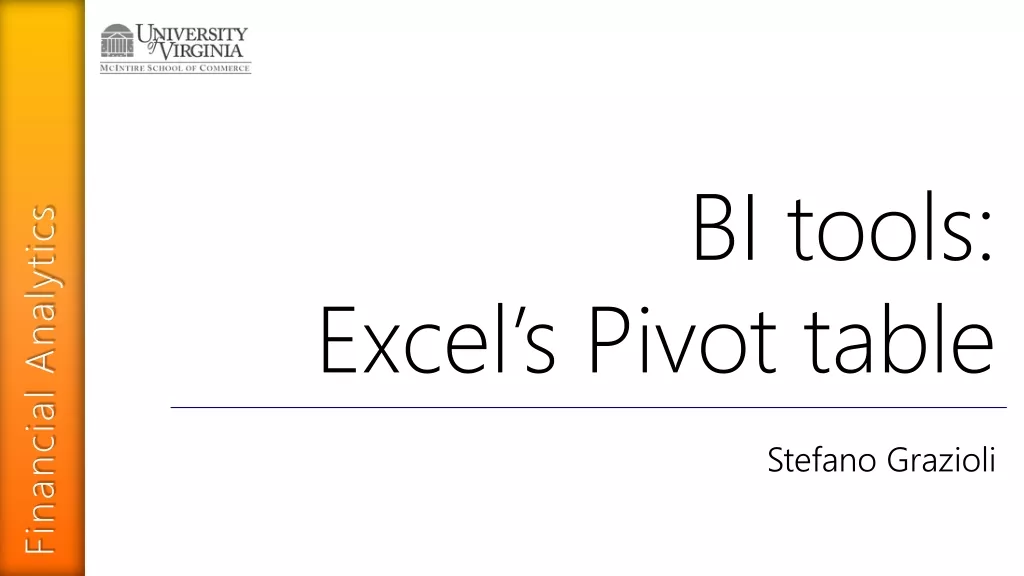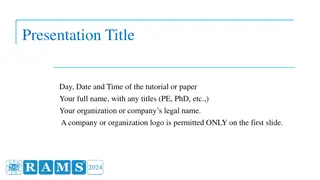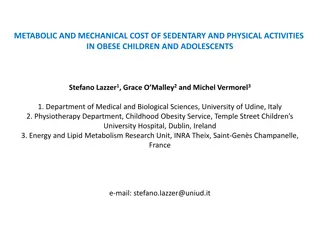
Factors Driving Customers in UK Retail Banking Market
Explore the factors driving customer searching and switching behaviors in the UK retail banking market as investigated by the Competition and Markets Authority (CMA). This analysis delves into the motivations, data, and implications for competition and consumer engagement in the industry.
Download Presentation

Please find below an Image/Link to download the presentation.
The content on the website is provided AS IS for your information and personal use only. It may not be sold, licensed, or shared on other websites without obtaining consent from the author. If you encounter any issues during the download, it is possible that the publisher has removed the file from their server.
You are allowed to download the files provided on this website for personal or commercial use, subject to the condition that they are used lawfully. All files are the property of their respective owners.
The content on the website is provided AS IS for your information and personal use only. It may not be sold, licensed, or shared on other websites without obtaining consent from the author.
E N D
Presentation Transcript
Searching and switching in retail banking Stefano Callari, Alexander Moore, Laura Rovegno Competition and Markets Authority Pasquale Schiraldi London School of Economics Although the authors worked on certain aspects of the retail banking market investigation at the UK Competition and Markets Authority (CMA), the views and opinions expressed in this paper are the sole responsibility of the authors and do not necessarily reflect those of the CMA or the inquiry group. 1
Introduction What factors drive customers to search for or switch to a new current account? The research was conducted as part of the CMA s official market inquiry into the retail banking market. The data we used are a combination of transactions data on retail banking customers and their responses to a detailed telephone survey. We estimate a bivariate recursive probit model in which: - the decisions to search and to switch are modelled jointly; and - the decision to search directly influences the decision to switch. 2
Motivation This analysis asks why people are (dis)engaged. What factors are associated with searching and switching? How do the two variables interact? Low searching or switching rates might indicate low customer engagement The (threat) of switching is a disciplining mechanism With low threat, the incentive to compete is weakened It is difficult for new entrants and smaller providers to expand organically. Competitive constraints are weakened Increased regulatory focus on demand side factors 3
Data Customer-level monthly transaction data on 120,000 customers from all major UK banks in 2014. The data included information on: - average credit and overdraft balance - value of payments and transfers into the account - number of days in credit and in arranged or unarranged overdraft - number of mobile banking app and internet banking logins - number of direct debits and standing orders Telephone survey with 4,549 respondents, oversampling switchers due to their small number. The survey included information on: - whether customers searched or switched for a new current account - general customer demographics (age, gender, income, educational qualification, working status) - customers' financial literacy and confidence in using internet - trigger factors (eg whether customers recently moved house or changed marital/living arrangements) 4
Searching and switching Customers are categorised as searchers if they responded that they had looked around at least once for a new current account. In the last three years have you looked around to see what different accounts are available? Analogously, they are categorised as switchers if they had switched their main current account to a different bank. Have you changed your main current account in the last three years? We focussed on customers who have searched for or switched to a new current account in the last 12 months and: - we excluded from the analysis: customers who responded that they had searched or switched in the last two to three years; and customers who responded that they had switched accounts within the same bank. - our reference group is made of : customers who did not search for or did not switch to a new current account at all; or customers who have not switched accounts within the same bank. 5
Descriptive statistics Groups Proportion of surveyed Number of observations (unweighted, N) sample (weighted, %) Non-searcher/non-switchers 65.4 2779 Searcher/non-switchers 14.2 574 Searcher/switchers 2.3 208 Non-searcher/switchers 0.8 115 Excluded* 17.4 873 100 4,549 * Notes: 1. We exclude from the analysis customers who responded that they had searched or switched in the last two to three years, as well as those who responded that they had switched accounts within the same bank. 2. Our reference group is the group of customers who have not searched or switched at any point in the last three years, and who have not switched accounts within the same bank. 6
Descriptive statistics 100% 100% 90% 90% 80% 80% 75% 70% 70% 60% 60% 50% 50% 40% 40% 30% 30% 17% 20% 20% 14% 10% 10% 3% 0% 0% Of those that search: % who switch Of those that switch: % who search % searching % switching 7
Methodology Customers decisions to search and switch are inter-dependent. We allow searching to affect the probability of switching. ?? ??????????,??????? = ? ? ???,??????? ??(???????|???) = ?(? ???) ? ??? ? ??? ? ? ? ? ???,??????,???~? , To account for the inter-dependency, we estimated a recursive bivariate probit model (eg Greene 1998). 8
Variables affecting searching affect switching through two channels: (a) Direct (b) Indirect (via search) The recursive structure allows us to estimate both. Univariate structure Recursive structure indirect direct Switch 4% Switch 0% Branch closure Branch closure Search 9% Search 9% 9
Marginal Effects Given that the model is non-linear, we need to compute marginal effects. Which required to estimate the following four joint probabilities: ?? ????? ?= 1,????? ?= 1 = ?2 ? ???+ ?,? ???,? ?? ????? ?= 1,????? ?= 0 = ?2 ? ??? ?,? ???, ? ?? ????? ?= 0,????? ?= 1 = ?2? ???, ? ???, ? ??(????? ?= 0,????? ?= 0) = ?2( ? ???, ? ???,? ) Standard errors for marginal effects were computed using bootstrapping and accounting for the survey structure (Rao et al. 1992). 10
Results (Searching) Coefficients Marginal effects Customer demographics Income below 24,000 -0.157** (0.0732) -0.041** (0.194) Degree 0.114* (0.066) 0.030* (0.017) Financial literacy 0.192*** (0.067) 0.050*** (0.016) Use of internet Internet confidence 0.560*** (0.102) 0.126*** (0.003) No internet banking -0.183** (0.080) -0.047** (0.020) No bank mobile app - - Monetary features Number of transactions -0.003** (0.001) -0.001* (0.000) Overdraft user -0.038 (0.073) -0.010 (0.019) High credit balance 0.195** (0.078) 0.053* (0.022) Bank of origin Large bank -0.133** (0.066) -0.036* (0.019) Trigger factors Local branch closed 0.304*** (0.112) 0.088** (0.036) Changed work status 0.189** (0.084) 0.052** (0.026) Observations 3,502 Notes: We also controlled for age groups and gender. *** p<0.01, ** p<0.05, * p<0.1. Standard errors in parentheses. 13
Results (Switching) Coefficients Marginal effects Direct effect Indirect effect Searching 0.154*** (0.526) 0.116*** (0.014) Customer demographics Income below 24,000 -0.095 (0.104) -0.013* (0.006) -0.006 -0.007 Degree -0.167* (0.091) -0.006 (0.006) -0.011 0.005 Financial literacy -0.021 (0.096) 0.006 (0.002) -0.001 0.008 Use of internet Internet confidence -0.164 (0.139) 0.010* (0.005) -0.013 0.022 No internet banking -0.007 (0.004) - - -0.007 No bank mobile app -0.210** (0.096) -0.014** (0.007) -0.014 - Monetary features Number of transactions -0.004** (0.002) -0.000** (0.000) -0.000 -0.000 Overdraft user -0.208** (0.102) -0.014** (0.005) -0.012 -0.002 High credit balance 0.117* (0.110) 0.017* (0.008) 0.009 0.008 Bank of origin Large bank -0.101 (0.101) -0.013* (0.007) -0.007 -0.006 Trigger factors Local branch closed 0.100 (0.158) 0.022 (0.015) 0.009 0.013 Changed work status 0.008* (0.005) - - 0.008 Observations Notes: We also controlled for age groups and gender. *** p<0.01, ** p<0.05, * p<0.1. Standard errors in parentheses. 3,502 14
Main results (Searching) Overall, we find much stronger results regarding the drivers of searching than for switching The main drivers of searching are: - Confidence in the use of internet, which is probably associated with reduced searching and switching costs when shopping around online. - Education and financial literacy - Holding high credit balances, which is probably associated with having more to gain from pull factors such as higher interest rates or cashbacks. - The closure of a local branch 15
Main results (Switching) Searching appears the sole most important driver for switching - Searchers are 12 percentage points more likely to switch than non- searchers. Conditional on searching, most drivers considered are not significant determinants of switching Only exception: overdraft users, as they are less likely to switch conditional on searching - Although overdraft users could potentially realise higher monetary gains by switching accounts, this does not translate in higher level of engagement. 16






















